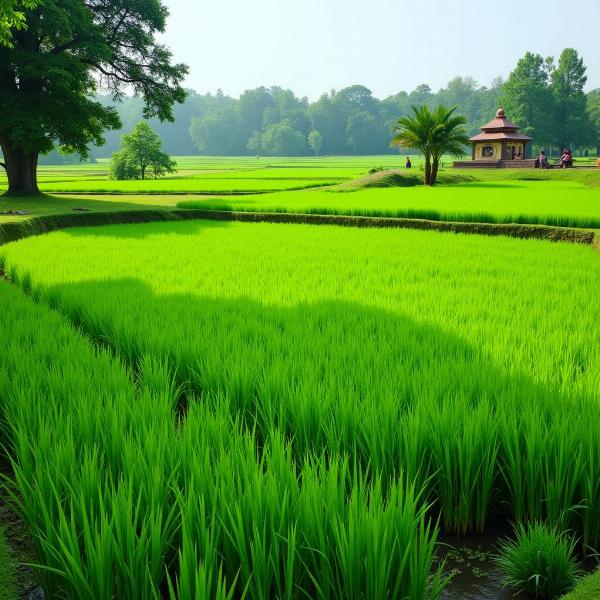Colour plays a significant role in Indian culture, deeply intertwined with traditions, spirituality, and everyday life. Understanding the meaning of colour in Hindi provides valuable insight into the rich tapestry of Indian symbolism. Whether it’s the vibrant hues of Holi or the subtle shades in a traditional saree, each colour conveys a specific message, evokes emotions, and represents a deeper cultural significance. Exploring the meaning of colour in Hindi unveils a fascinating world of cultural nuances and traditions.
Unravelling the Significance of Colours in Indian Culture
Colours are more than just visual elements in India; they are powerful symbols imbued with cultural, religious, and spiritual meaning. They are woven into the fabric of daily life, expressed in festivals, clothing, rituals, and even food. From the auspicious red of a wedding to the calming white of mourning, each colour holds a unique place in the Indian psyche. Knowing the meaning of colour in Hindi enhances one’s appreciation of this vibrant culture.
Red (लाल – Laal): The Colour of Passion and Auspiciousness
Red is perhaps the most prominent colour in Indian culture. It signifies auspiciousness, love, passion, and fertility. Brides traditionally wear red, and it’s the dominant colour during festivals like Holi and Diwali. Red is also associated with the goddess Durga, a symbol of power and strength.
Yellow (पीला – Peela): The Colour of Knowledge and Learning
Yellow is associated with knowledge, learning, and piety. It’s often worn by scholars and holy men. Turmeric, a vibrant yellow spice, is considered sacred and used in many religious ceremonies. Yellow also represents happiness, peace, and prosperity.
Green (हरा – Hara): The Colour of Nature and Prosperity
Green symbolises nature, fertility, prosperity, and new beginnings. It is the colour of life and renewal. It is associated with the deities Krishna and Vishnu, representing harmony and peace.
 Green Colour Meaning: Nature and Prosperity
Green Colour Meaning: Nature and Prosperity
White (सफेद – Safed): The Colour of Purity and Peace
White represents purity, peace, and mourning. It is often worn during funerals and periods of mourning. White is also associated with simplicity, cleanliness, and detachment.
Blue (नीला – Neela): The Colour of Courage and Strength
Blue, especially the deep indigo shade, is associated with Lord Krishna, symbolising courage, strength, and the infinite. It is also associated with the vastness of the sky and ocean, representing depth and mystery.
Orange (नारंगी – Narangi): The Colour of Fire and Renunciation
Orange, a sacred colour in Hinduism, signifies fire, renunciation, and the pursuit of spiritual knowledge. It’s often worn by sadhus (holy men) and is associated with the divine fire that burns away impurities.
The Language of Colours in Everyday Life
From clothing choices to the decorations used during festivals, the meaning of colour in Hindi permeates daily life in India. Understanding these meanings provides a deeper appreciation for the cultural context. For example, wearing certain colours during specific occasions can convey respect and adherence to tradition.
Meaning of Colour in Hindi: A Deeper Dive into Cultural Significance
The significance of colour goes beyond simple symbolism. It reflects a complex interplay of religious beliefs, philosophical concepts, and social customs. Exploring the meaning of colour in Hindi reveals a fascinating layer of cultural depth.
Conclusion
Understanding the meaning of colour in Hindi provides a valuable key to unlocking the rich symbolism of Indian culture. From the vibrant hues of festivals to the subtle shades in everyday life, colours speak a language that transcends words, expressing emotions, beliefs, and traditions. By appreciating the meaning of colours, we gain a deeper understanding and respect for the cultural tapestry of India. The exploration of colour meaning in Hindi offers a fascinating journey into the heart of Indian culture.
FAQ
- What does the colour red symbolise in Indian culture? Red symbolises auspiciousness, love, passion, and fertility.
- Why is yellow considered sacred in India? Yellow is associated with knowledge, learning, piety, and the use of turmeric in religious ceremonies.
- What is the significance of green in Hindu mythology? Green symbolises nature, prosperity, and is associated with deities like Krishna and Vishnu.
- Why do people wear white during mourning in India? White represents purity, peace, and is traditionally worn during funerals and periods of mourning.
- What does blue represent in Hinduism? Blue, particularly indigo, is associated with Lord Krishna, symbolising courage, strength, and the infinite.
- What is the cultural significance of orange in India? Orange signifies fire, renunciation, and the pursuit of spiritual knowledge, often associated with Sadhus.
- How does understanding colour meaning enhance my appreciation of Indian culture? Understanding colour meanings provides deeper insights into the symbolism embedded in Indian traditions, rituals, and everyday life.
Related Articles
- black colour meaning in hindi
- green colour meaning in hindi
- light colour meaning in hindi
- lavender colour meaning in hindi
Meaning-Hindi.in is your trusted partner for accurate and culturally sensitive Hindi translation services. We specialize in various domains, including business, legal, technical, website localization, educational, and specialized translations. Our expertise covers a wide range of subjects, ensuring that your message is conveyed effectively in Hindi while respecting the cultural nuances of the language. For all your Hindi translation needs, contact us at [email protected] or +91 11-4502-7584. Meaning-Hindi.in is dedicated to bridging the language gap and fostering clear communication.